CADILLAC ESCALADE 2010 3.G Owners Manual
Manufacturer: CADILLAC, Model Year: 2010, Model line: ESCALADE, Model: CADILLAC ESCALADE 2010 3.GPages: 616, PDF Size: 39.41 MB
Page 521 of 616
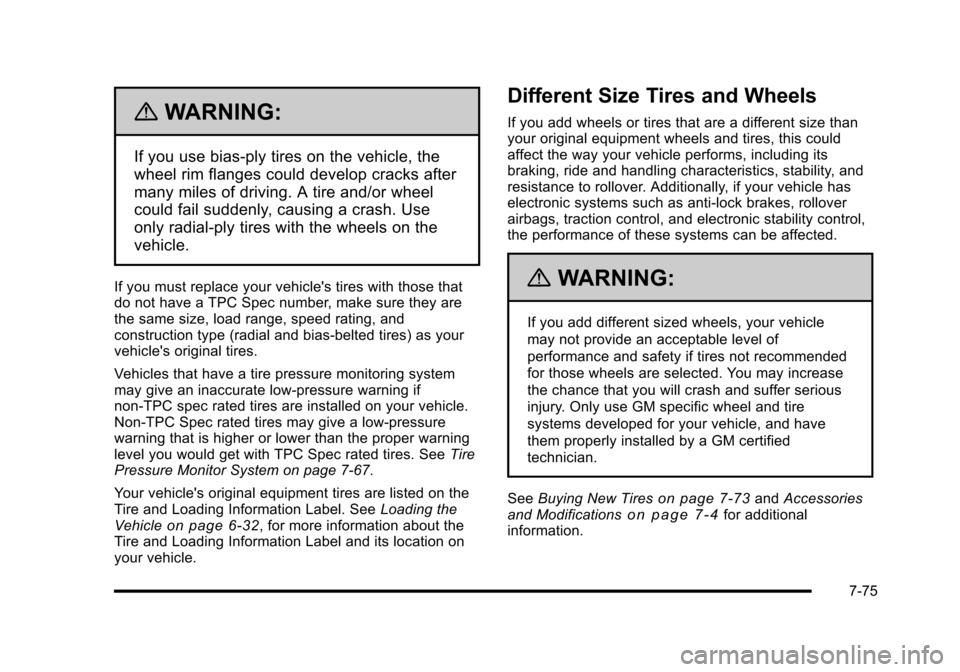
{WARNING:
If you use bias-ply tires on the vehicle, the
wheel rim flanges could develop cracks after
many miles of driving. A tire and/or wheel
could fail suddenly, causing a crash. Use
only radial-ply tires with the wheels on the
vehicle.
If you must replace your vehicle's tires with those thatdo not have a TPC Spec number, make sure they arethe same size, load range, speed rating, andconstruction type (radial and bias!belted tires) as yourvehicle's original tires.
Vehicles that have a tire pressure monitoring systemmay give an inaccurate low!pressure warning ifnon!TPC spec rated tires are installed on your vehicle.Non!TPC Spec rated tires may give a low!pressurewarning that is higher or lower than the proper warninglevel you would get with TPC Spec rated tires. SeeTirePressure Monitor System on page 7!67.
Your vehicle's original equipment tires are listed on theTire and Loading Information Label. SeeLoading theVehicleon page 6!32, for more information about theTire and Loading Information Label and its location onyour vehicle.
Different Size Tires and Wheels
If you add wheels or tires that are a different size thanyour original equipment wheels and tires, this couldaffect the way your vehicle performs, including itsbraking, ride and handling characteristics, stability, andresistance to rollover. Additionally, if your vehicle haselectronic systems such as anti!lock brakes, rolloverairbags, traction control, and electronic stability control,the performance of these systems can be affected.
{WARNING:
If you add different sized wheels, your vehicle
may not provide an acceptable level of
performance and safety if tires not recommended
for those wheels are selected. You may increase
the chance that you will crash and suffer serious
injury. Only use GM specific wheel and tire
systems developed for your vehicle, and have
them properly installed by a GM certified
technician.
SeeBuying New Tireson page 7!73andAccessoriesand Modificationso n p a g e 7!4for additionalinformation.
7-75
Page 522 of 616
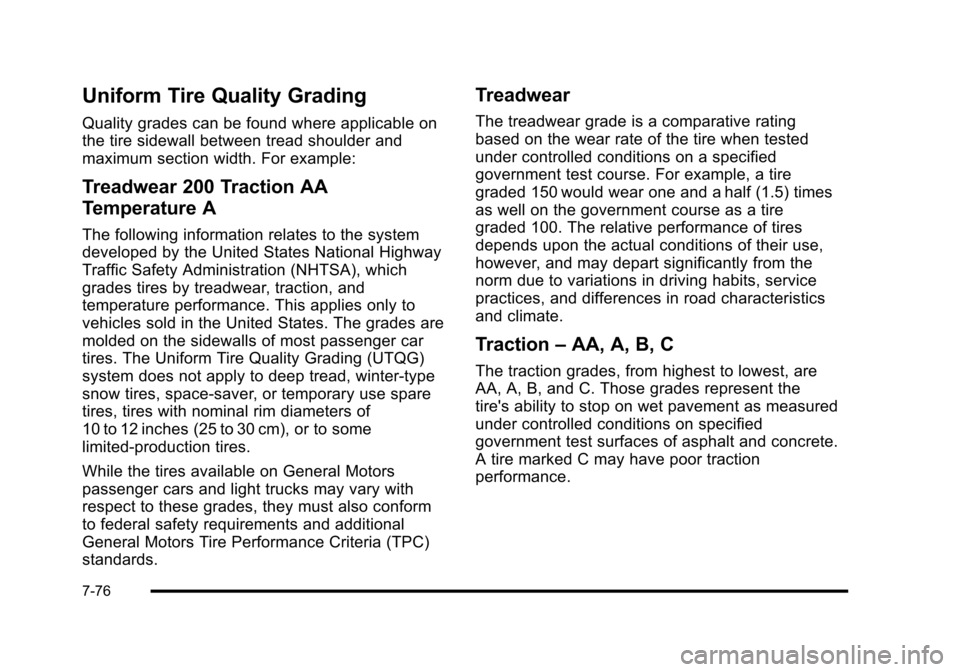
Uniform Tire Quality Grading
Quality grades can be found where applicable on
the tire sidewall between tread shoulder and
maximum section width. For example:
Treadwear 200 Traction AA
Temperature A
The following information relates to the system
developed by the United States National Highway
Traffic Safety Administration (NHTSA), which
grades tires by treadwear, traction, and
temperature performance. This applies only to
vehicles sold in the United States. The grades are
molded on the sidewalls of most passenger car
tires. The Uniform Tire Quality Grading (UTQG)
system does not apply to deep tread, winter-type
snow tires, space-saver, or temporary use spare
tires, tires with nominal rim diameters of
10 to 12 inches (25 to 30 cm), or to some
limited-production tires.
While the tires available on General Motors
passenger cars and light trucks may vary with
respect to these grades, they must also conform
to federal safety requirements and additional
General Motors Tire Performance Criteria (TPC)
standards.
Treadwear
The treadwear grade is a comparative rating
based on the wear rate of the tire when tested
under controlled conditions on a specified
government test course. For example, a tire
graded 150 would wear one and a half (1.5) times
as well on the government course as a tire
graded 100. The relative performance of tires
depends upon the actual conditions of their use,
however, and may depart significantly from the
norm due to variations in driving habits, service
practices, and differences in road characteristics
and climate.
Traction–AA, A, B, C
The traction grades, from highest to lowest, are
AA, A, B, and C. Those grades represent the
tire's ability to stop on wet pavement as measured
under controlled conditions on specified
government test surfaces of asphalt and concrete.
A tire marked C may have poor traction
performance.
7-76
Page 523 of 616
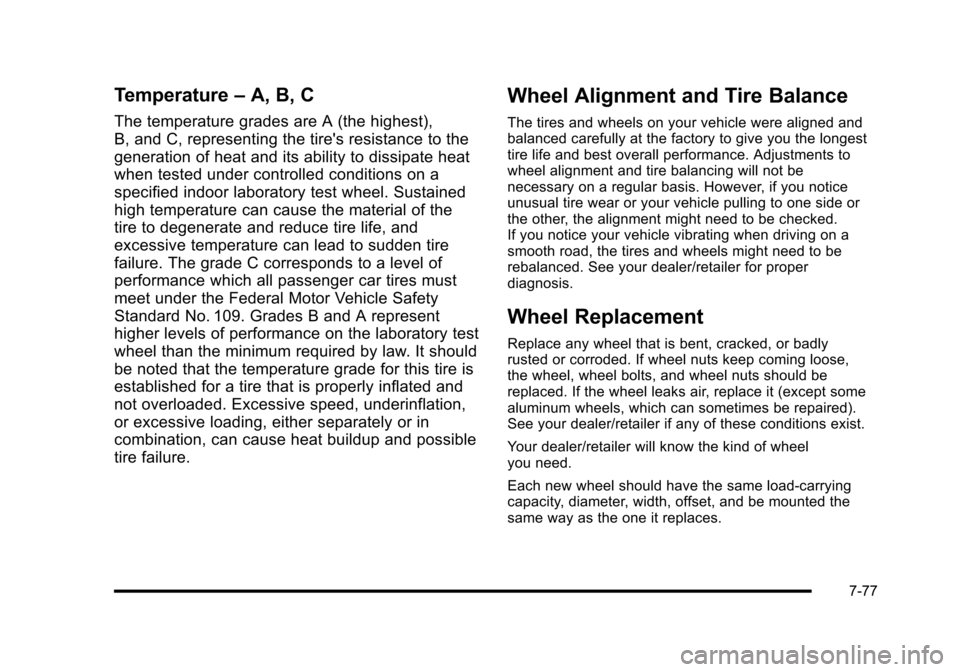
Temperature–A, B, C
The temperature grades are A (the highest),
B, and C, representing the tire's resistance to the
generation of heat and its ability to dissipate heat
when tested under controlled conditions on a
specified indoor laboratory test wheel. Sustained
high temperature can cause the material of the
tire to degenerate and reduce tire life, and
excessive temperature can lead to sudden tire
failure. The grade C corresponds to a level of
performance which all passenger car tires must
meet under the Federal Motor Vehicle Safety
Standard No. 109. Grades B and A represent
higher levels of performance on the laboratory test
wheel than the minimum required by law. It should
be noted that the temperature grade for this tire is
established for a tire that is properly inflated and
not overloaded. Excessive speed, underinflation,
or excessive loading, either separately or in
combination, can cause heat buildup and possible
tire failure.
Wheel Alignment and Tire Balance
The tires and wheels on your vehicle were aligned andbalanced carefully at the factory to give you the longesttire life and best overall performance. Adjustments towheel alignment and tire balancing will not benecessary on a regular basis. However, if you noticeunusual tire wear or your vehicle pulling to one side orthe other, the alignment might need to be checked.If you notice your vehicle vibrating when driving on asmooth road, the tires and wheels might need to berebalanced. See your dealer/retailer for properdiagnosis.
Wheel Replacement
Replace any wheel that is bent, cracked, or badlyrusted or corroded. If wheel nuts keep coming loose,the wheel, wheel bolts, and wheel nuts should bereplaced. If the wheel leaks air, replace it (except somealuminum wheels, which can sometimes be repaired).See your dealer/retailer if any of these conditions exist.
Your dealer/retailer will know the kind of wheelyou need.
Each new wheel should have the same load-carryingcapacity, diameter, width, offset, and be mounted thesame way as the one it replaces.
7-77
Page 524 of 616

If you need to replace any of your wheels, wheel bolts,wheel nuts, or Tire Pressure Monitor System (TPMS)sensors, replace them only with new GM originalequipment parts. This way, you will be sure to havethe right wheel, wheel bolts, wheel nuts, and TPMSsensors for your vehicle.
{WARNING:
Using the wrong replacement wheels, wheel bolts,
or wheel nuts on your vehicle can be dangerous.
It could affect the braking and handling of your
vehicle, make your tires lose air and make you
lose control. You could have a collision in which
you or others could be injured. Always use the
correct wheel, wheel bolts, and wheel nuts for
replacement.
Notice:The wrong wheel can also cause problemswith bearing life, brake cooling, speedometer orodometer calibration, headlamp aim, bumper height,vehicle ground clearance, and tire or tire chainclearance to the body and chassis.
SeeChanging a Flat Tireon page 7!80for moreinformation.
Used Replacement Wheels
{WARNING:
Putting a used wheel on the vehicle is dangerous.
You cannot know how it has been used or how
far it has been driven. It could fail suddenly and
cause a crash. If you have to replace a wheel,
use a new GM original equipment wheel.
Tire Chains
{WARNING:
Do not use tire chains. There is not enough
clearance. Tire chains used on a vehicle without
the proper amount of clearance can cause
damage to the brakes, suspension, or other
vehicle parts. The area damaged by the tire
chains could cause you to lose control of the
vehicle and you or others may be injured in a
crash. Use another type of traction device only if
its manufacturer recommends it for use on the
(Continued)
7-78
Page 525 of 616
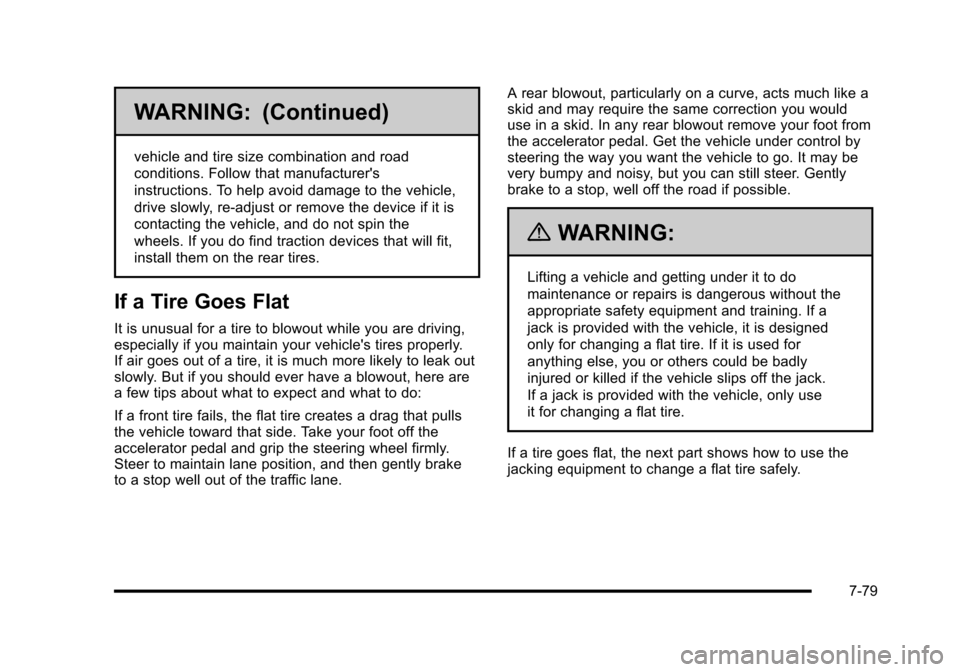
WARNING: (Continued)
vehicle and tire size combination and road
conditions. Follow that manufacturer's
instructions. To help avoid damage to the vehicle,
drive slowly, re!adjust or remove the device if it is
contacting the vehicle, and do not spin the
wheels. If you do find traction devices that will fit,
install them on the rear tires.
If a Tire Goes Flat
It is unusual for a tire to blowout while you are driving,especially if you maintain your vehicle's tires properly.If air goes out of a tire, it is much more likely to leak outslowly. But if you should ever have a blowout, here area few tips about what to expect and what to do:
If a front tire fails, the flat tire creates a drag that pullsthe vehicle toward that side. Take your foot off theaccelerator pedal and grip the steering wheel firmly.Steer to maintain lane position, and then gently braketo a stop well out of the traffic lane.
A rear blowout, particularly on a curve, acts much like askid and may require the same correction you woulduse in a skid. In any rear blowout remove your foot fromthe accelerator pedal. Get the vehicle under control bysteering the way you want the vehicle to go. It may bevery bumpy and noisy, but you can still steer. Gentlybrake to a stop, well off the road if possible.
{WARNING:
Lifting a vehicle and getting under it to do
maintenance or repairs is dangerous without the
appropriate safety equipment and training. If a
jack is provided with the vehicle, it is designed
only for changing a flat tire. If it is used for
anything else, you or others could be badly
injured or killed if the vehicle slips off the jack.
If a jack is provided with the vehicle, only use
it for changing a flat tire.
If a tire goes flat, the next part shows how to use thejacking equipment to change a flat tire safely.
7-79
Page 526 of 616
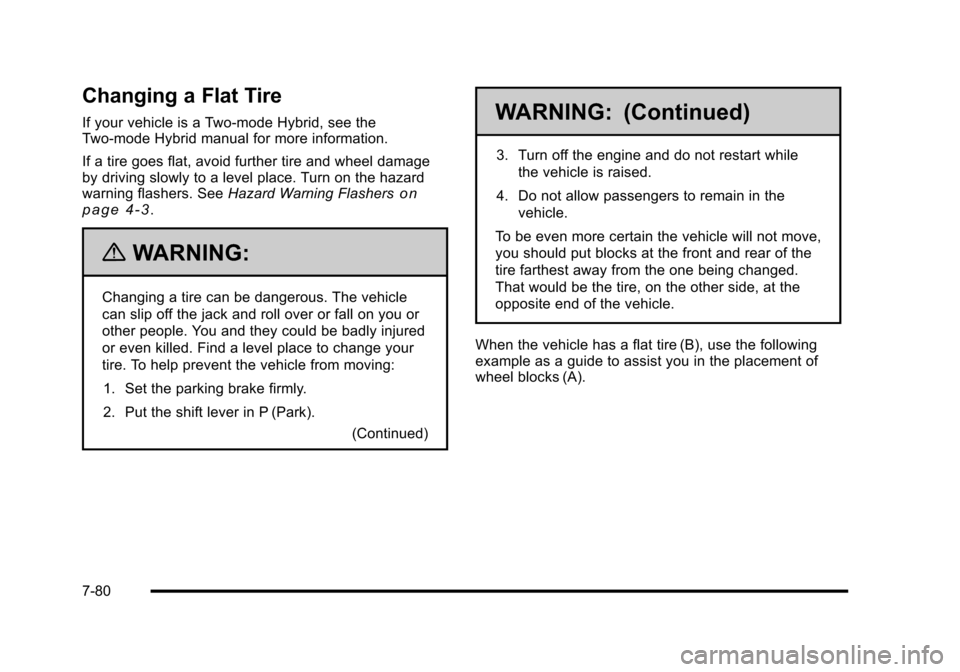
Changing a Flat Tire
If your vehicle is a Two-mode Hybrid, see theTwo-mode Hybrid manual for more information.
If a tire goes flat, avoid further tire and wheel damageby driving slowly to a level place. Turn on the hazardwarning flashers. SeeHazard Warning Flashersonp a g e 4!3.
{WARNING:
Changing a tire can be dangerous. The vehicle
can slip off the jack and roll over or fall on you or
other people. You and they could be badly injured
or even killed. Find a level place to change your
tire. To help prevent the vehicle from moving:
1. Set the parking brake firmly.
2. Put the shift lever in P (Park).
(Continued)
WARNING: (Continued)
3. Turn off the engine and do not restart while
the vehicle is raised.
4. Do not allow passengers to remain in the
vehicle.
To be even more certain the vehicle will not move,
you should put blocks at the front and rear of the
tire farthest away from the one being changed.
That would be the tire, on the other side, at the
opposite end of the vehicle.
When the vehicle has a flat tire (B), use the followingexample as a guide to assist you in the placement ofwheel blocks (A).
7-80
Page 527 of 616
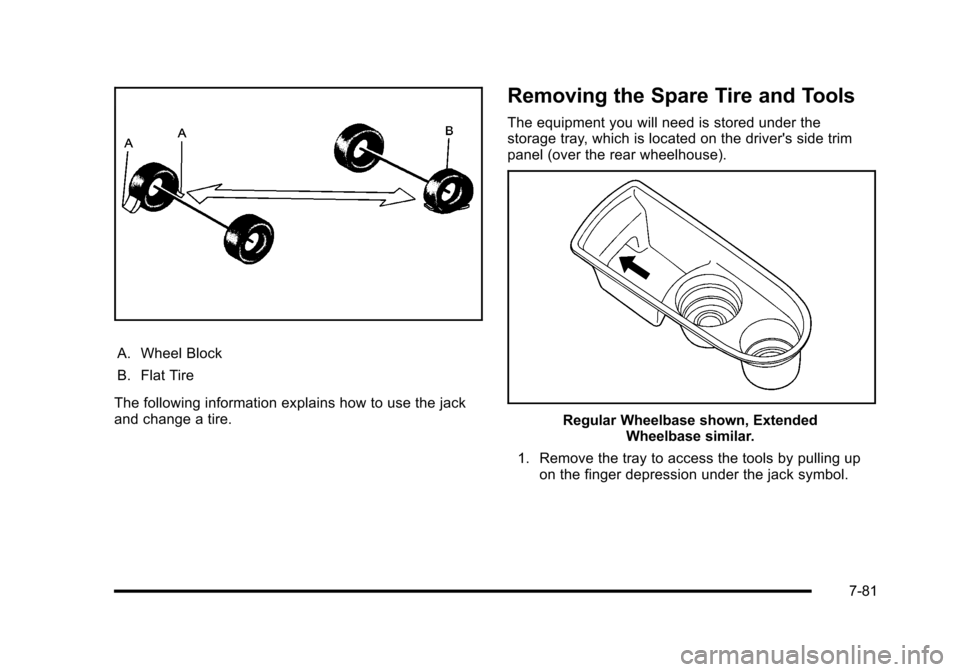
A. Wheel Block
B. Flat Tire
The following information explains how to use the jackand change a tire.
Removing the Spare Tire and Tools
The equipment you will need is stored under thestorage tray, which is located on the driver's side trimpanel (over the rear wheelhouse).
Regular Wheelbase shown, ExtendedWheelbase similar.
1. Remove the tray to access the tools by pulling upon the finger depression under the jack symbol.
7-81
Page 528 of 616
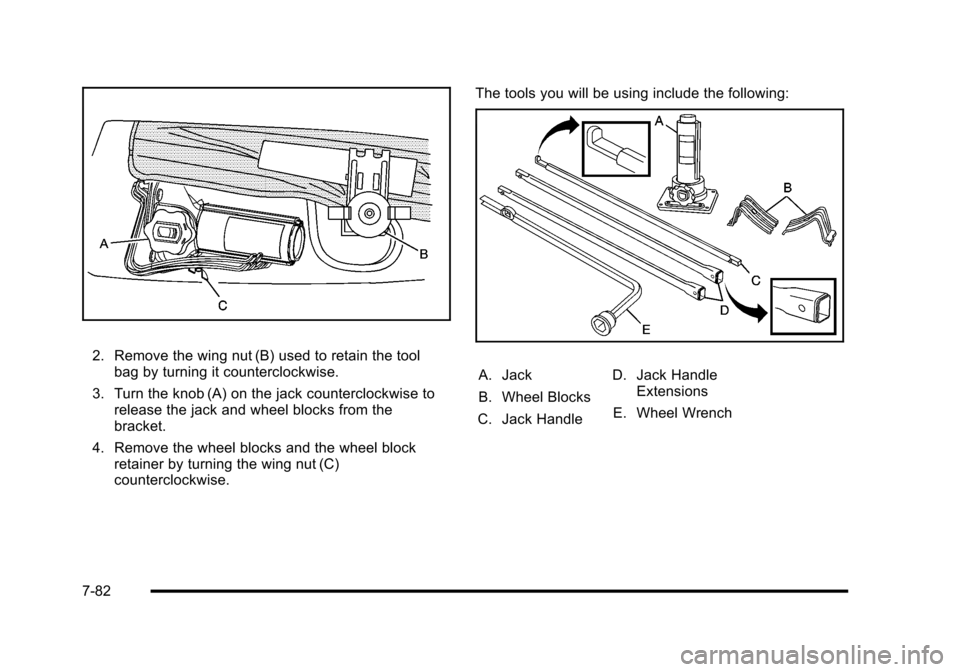
2. Remove the wing nut (B) used to retain the toolbag by turning it counterclockwise.
3. Turn the knob (A) on the jack counterclockwise torelease the jack and wheel blocks from thebracket.
4. Remove the wheel blocks and the wheel blockretainer by turning the wing nut (C)counterclockwise.
The tools you will be using include the following:
A. Jack
B. Wheel Blocks
C. Jack Handle
D. Jack HandleExtensions
E. Wheel Wrench
7-82
Page 529 of 616
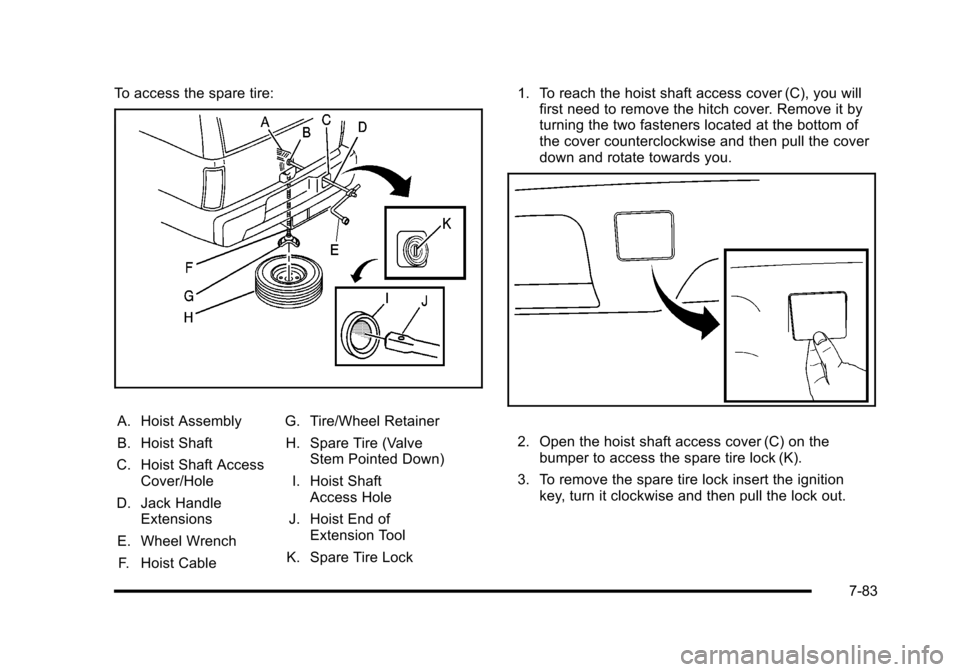
To access the spare tire:
A. Hoist Assembly
B. Hoist Shaft
C. Hoist Shaft AccessCover/Hole
D. Jack HandleExtensions
E. Wheel Wrench
F. Hoist Cable
G. Tire/Wheel Retainer
H. Spare Tire (ValveStem Pointed Down)
I. Hoist ShaftAccess Hole
J. Hoist End ofExtension Tool
K. Spare Tire Lock
1. To reach the hoist shaft access cover (C), you willfirst need to remove the hitch cover. Remove it byturning the two fasteners located at the bottom ofthe cover counterclockwise and then pull the coverdown and rotate towards you.
2. Open the hoist shaft access cover (C) on thebumper to access the spare tire lock (K).
3. To remove the spare tire lock insert the ignitionkey, turn it clockwise and then pull the lock out.
7-83
Page 530 of 616
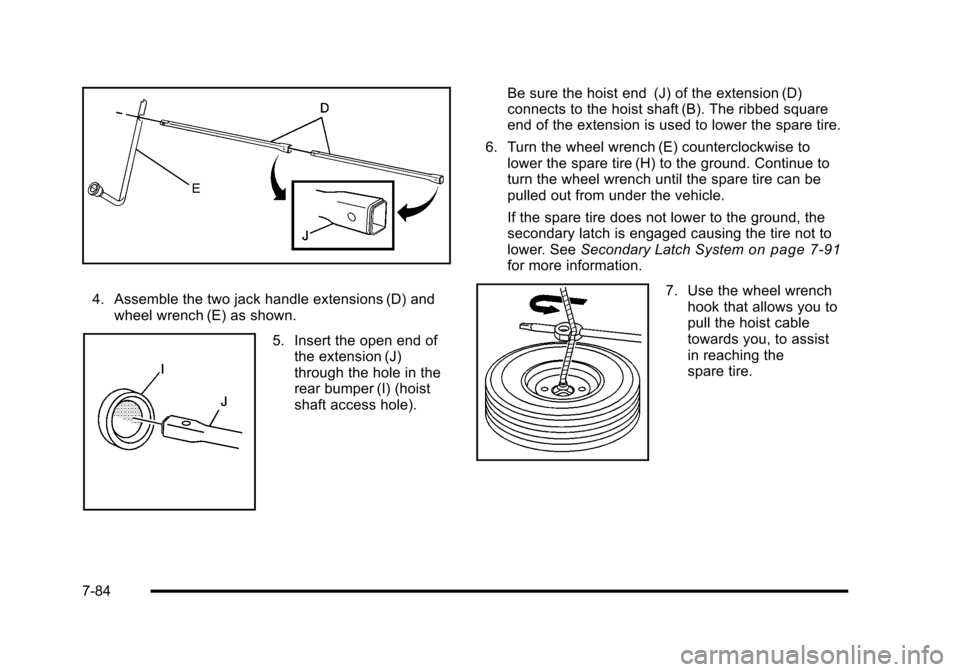
4. Assemble the two jack handle extensions (D) andwheel wrench (E) as shown.
5. Insert the open end ofthe extension (J)through the hole in therear bumper (I) (hoistshaft access hole).
Be sure the hoist end (J) of the extension (D)connects to the hoist shaft (B). The ribbed squareend of the extension is used to lower the spare tire.
6. Turn the wheel wrench (E) counterclockwise tolower the spare tire (H) to the ground. Continue toturn the wheel wrench until the spare tire can bepulled out from under the vehicle.
If the spare tire does not lower to the ground, thesecondary latch is engaged causing the tire not tolower. SeeSecondary Latch Systemon page 7!91for more information.
7. Use the wheel wrenchhook that allows you topull the hoist cabletowards you, to assistin reaching thespare tire.
7-84